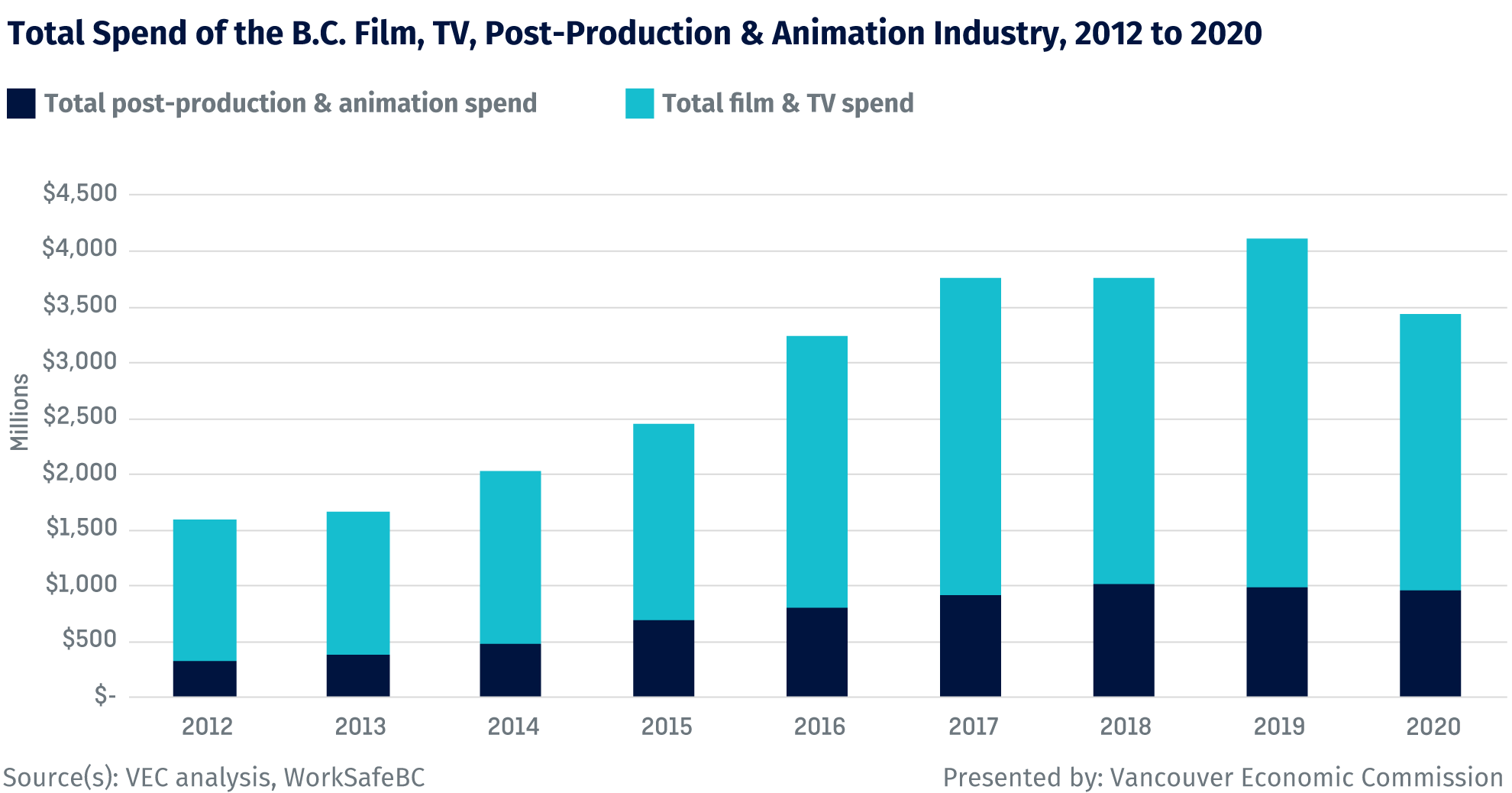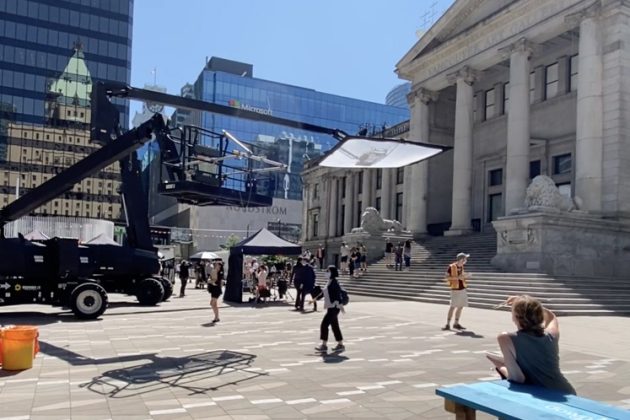Industry acted as economic lifeline during pandemic, paying more than $1.9 billion in local wages in 2020
According to the Vancouver Economic Commission’s (VEC) annual film spend research, the local film, television, post-production and animation industries generated an impressive $3.4 billion in direct spending for the provincial economy despite months of filming delays caused by COVID-19. While the $3.4 billion spent in the 2020 calendar year represents a 16.6 percent year-over-year drop from the record-shattering $4.1 billion in 2019, this volume came as a pleasant surprise to even optimistic industry stakeholders.
“There’s no doubt that the industry has been a lifeline to many British Columbians during the pandemic, but we can’t forget that B.C. talent, creatives and workers have in turn been a lifeline for the industry as a whole, particularly with so many disruptions in other global film hubs,” says Geoff Teoli, Vancouver’s acting film commissioner.
Since 2012, the industry has collectively invested $26 billion into the provincial economy, $14.4 billion of which have been paid directly as wages to British Columbians.
The local film and TV industry weathered the effects of the pandemic better than many other global film hubs thanks to B.C.’s relatively low COVID-19 case count, the quick response by experienced production staff and crews, and co-operative problem-solving between provincial health authorities and industry leaders.
“We are tremendously proud that B.C.’s film industry adapted quickly and returned to set once pandemic protocols were in place,” says Creative BC CEO Prem Gill. “The industry is an important contributor to the economy and to employment in B.C., with crews and companies demonstrating exemplary resilience through very tough and uncertain times in 2020.”
Furthermore, visual effects and animation companies transitioned thousands of employees to remote working models almost overnight. The entire post-production and animation industry saw fluctuations from global capital flows and COVID-related production delays, and the visual effects subsector in particular experienced knock-on effects from set disruptions and production hiatuses. However, the animation subsector remained buoyant, and the spike in demand for fresh content throughout the pandemic – along with federal business relief programs during the worst of the pandemic – helped keep artists and creators employed.
“16.6 percent may seem like a significant drop. However, prior to 2017, people hadn’t realized the film industry had so much as cracked the $2.5 billion mark,” Teoli comments. “The $3.2 billion spent in 2016 represented a record-smashing landmark year, and physical production has been on an upward trend ever since. Put in context, $3.4 billion is a truly impressive performance during a pandemic year.”
The minor dip in spending by the overall post-production sector suggests that visual effects professionals impacted by set production pauses may have found work beyond the features and series segment serviced by many Vancouver-based VFX and animation houses. Given shifts in remote working models, it could also suggest that independent contractors and gig workers in the industry picked up temporary work from employers based outside the region. These could be topics for exploration in future research on industry spending.
Context and outlook: the picture historical data and current trends paints for B.C. industry
A study by Film L.A. on 2020 television spending published earlier this year noted that B.C. and Vancouver accounted for two-thirds of all new streaming projects in Canada (16) while Ontario and the Greater Toronto Area hosted seven, and Alberta and Calgary accounted for the remaining one. In total, British Columbia hosted 48 live-action scripted television series in 2020 – a year-over-year increase of 30 percent. Ontario experienced meteoric growth in 2020, hosting a total of 25 scripted series, representing a two-thirds increase of 66.7 percent over 2019.
“The outlook is encouraging – demand for crews, talent and filming has not slowed down in the region,” Teoli adds, “We must ensure that support at all levels for this crucial industry remains steady as the economy reopens and we ramp up activity.”
The future is especially bright for the animation industry: on August 4, Walt Disney Animation Studios has announced a new studio in Vancouver – a rare expansion beyond their Burbank headquarters – dedicated to long-form series and special features for the Disney+ platform. Visual effects and animation giant Double Negative (DNEG) also announced it will be adding hundreds of feature animation jobs across Canada, with Vancouver anticipating another 150 new positions in the animation division on top of the hundreds of visual effects ones at DNEG’s local visual effects studio.
“Vancouver is a world-class destination for this industry, easily ranking among the very top in North America,” remarks Vancouver Mayor Kennedy Stewart. “The past forty-five years have cemented the film industry as a crucial economic pillar for our city, employing tens of thousands of Vancouver residents in diverse, well-paying jobs and paying billions in wages. I look forward to continuing to support the work of the Vancouver film commission and our regional partners in positioning and growing Vancouver as a leading global centre to film and animation production, talent, and investment.”
These recent studio announcements serve as an industry signal to the rest of the world: to studios, Vancouver has the talent and a robust industry cluster; to experienced talent, Vancouver has the prospects to build or enhance an animation and visual effects career; to young or reskilling professionals, gaining skills for visual effects and animation could yield employment in a resilient sector.
“Content spending has reached new heights in the last year, with no signs of slowing down,” says Jennifer Twiner McCarron, CEO, President and Director of Thunderbird Entertainment and Atomic Cartoons. “At-home audiences continue to grow, and the stakes just keep getting higher for streamers looking to glue the key “co-viewing audience” of kids and families. With all the major streamers and broadcasters like Apple, Netflix and Disney+ increasing their global spend, award-winning content producers like Atomic are poised to continue benefiting from this exponential growth.”
Numbers at a Glance: BC Film Spending in 2020 and in the years prior

These numbers illustrate the sector’s direct economic impact. However, they omit the indirect economic benefits the film industry has on many other sectors, such as the beleaguered tourism, accommodation, hospitality and transportation, all of which were hit hard by COVID-19.
- Total direct spend in 2020 was $3,432,055,159, or $3.4 billion
- Since 2012, the film and television, post-production and animation industries have collectively invested $26,083,245,454, or $26.1 billion, in the provincial economy
- Of this, $14,354,348,240 or $14.4 billion has been paid to British Columbians as salaries and wages
- According to Creative BC’s 2020 Impact Report, the sector employs a total of 65,000 gig and freelance workers, or the equivalent of approximately 35,000 full-time and equivalent jobs in B.C.
Methodology
VEC uses publicly available data, including data obtained through WorkSafe BC, to calculate the total payroll for the film, television, post-production and animation industry in B.C. (as defined by classification units 763025 and 763024).
VEC estimates the ratios of payroll to total spend for the industry using existing CAVCO data and through consultation with industry experts and financial & HR staff at leading film, television, post-production and animation companies.
- This research encompasses feature films, television series, commercials, documentaries, animation, and all post-production activities, but does not include TV broadcasting, games development or videography services (such as live event recording).
- The categories do include some spending on visual effects and animation work performed outside of the feature film & television industries (e.g., advertising, video games, education, etc.)
- Datasets are for the calendar year (rather than fiscal year)
This methodology has been independently validated and approved by PwC and their team of global media experts.
Media Contact
If you are a journalist interested in an interview for this story, or would like additional information, a high-quality graphic or other visual, please contact:
Ingrid Valou, Communications and Media Relations Specialist
+1 (604) 868-1990 | ivalou@vancouvereconomic.com
About the Vancouver Economic Commission
The Vancouver Economic Commission (VEC) serves one of the world’s fastest-growing, low-carbon economies. VEC strengthens Vancouver’s economic future by providing programs, supporting local companies, convening with purpose, attracting targeted high-impact investment, and conducting and publishing thoughtful leading-edge industry research. As the economic development agency for the City of Vancouver, VEC contributes to building a prosperous, inclusive, zero-carbon and resilient Vancouver economy, competitively positioned in the global market.
VEC is an external agency of the City of Vancouver governed by the Societies Act.
VEC respectfully acknowledges that it is located on the unceded ancestral territories of the xʷməθkʷəy̓əm (Musqueam), Sḵwx̱wú7mesh (Squamish), and səl̓ilwətaɁɬ / sel̓íl̓witulh (Tsleil-Waututh) Nations.
Photo: Photo by cottonbro from Pexels



